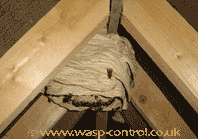- Get rid of wasps
- Wasp nest problem
- Wasps active in winter
- Wasp traps
- Controlling the wasp problem.
- How Wasp Nests are destroyed
- How long before a wasp nest dies after treatment?
- Can a wasp nest be destroyed immediately?
- Should i treat a wasp nest myself?
- Small grey nest in spring
- Aggressive wasps
- When wasps attack
- Blocking wasp nest entrances
Getting rid of Wasps & Wasp Nest Treatment
Dealing with Wasp Nests: A Guide to Treatment and Removal
When it comes to addressing wasp-related issues, there are three distinct scenarios you might face:
- 1. Presence of an active wasp nest on your property.
- 2. Hibernating queen wasps awakening prematurely.
- 3. Nuisance wasps causing trouble when the nest location is unknown.
This guide will provide comprehensive coverage for each of these situations.
Dealing with Active Wasp Nests: A Professional Approach
Understanding the Need for Professional Treatment
If you're faced with the task of eliminating wasps and discover an active nest on your property, relying on professional wasp control is the most straightforward and secure option.
The Risks of DIY Wasp Removal
Wasps, naturally protective of their nests, may sting unprovoked when approached. Proximity to a nest near your home or in your garden increases the risk of being stung. The consequences of wasp stings extend beyond pain, as they also pose a risk of infection.
Hidden Dangers in Wasp Stings
As predators, wasps spend time hunting in areas where smaller insects thrive, often in unsanitary conditions. The risk of infection is heightened as wasps drag their stingers through dirt and bacteria during their hunting activities. As wasps age, the venom sack becomes a breeding ground for bacteria, adding an unhealthy element to the sting.
Caution with DIY Products
While various DIY products claim to eliminate wasps, the decision to tackle the issue independently should be approached cautiously. Attempting to save money with DIY solutions can be tempting, but it may lead to dangerous situations if not executed correctly. Many individuals seek professional assistance after unsuccessful attempts at nest removal, often due to overwhelming defensive reactions from the wasps.
Coping with Winter Intruders: Queen Wasps in Your Home
Navigating Climate-Driven Challenges
In the face of evolving climates, a growing number of individuals are reaching out to us during milder winters, reporting the unwelcome presence of large wasps (queens) indoors. This issue becomes pronounced when the ambient temperature consistently surpasses 7°C. The queens, stirred by the temperature increase, often find their way into homes through openings and are drawn to sources of light. Typically, these queens choose to hibernate in loft spaces, attracted by the stability of temperature and the encompassing darkness.
Deploying Professional Fogging Machines
Addressing this problem involves the expertise of professional pest controllers equipped with fogging machines. These machines disperse a liquid insecticide into the loft area, forming a fine mist that effectively treats the entire space. This strategic approach proves highly efficient in eliminating queen wasps that have intruded due to climatic conditions, offering a thorough solution to the issue at hand.
Expanding Measures Against Winter Intruders
In addition to the challenges presented by queen wasps infiltrating homes during milder winters, the battle extends to the potential disruptions associated with these intrusions. Beyond being an unwelcome presence, queen wasps can introduce complications to the household environment. Their search for shelter may inadvertently disturb the peace, and their ability to attract other wasps could compound the issue. Professional pest controllers not only address the immediate intrusion but also assess and manage potential disturbances, ensuring a comprehensive and lasting solution to safeguard your home from the winter invasion of queen wasps.
Tackling Wasp Challenges When the Nest Eludes Discovery
Dealing with bothersome wasps can be quite a hassle, especially when the elusive nest remains hidden from sight. Fret not! Our expert assistance not only resolves the immediate issue of wasps causing trouble but also includes proactive measures to ward off future occurrences. Rest assured, we've got you covered in addressing the present predicament and fortifying against potential future nuisances.
Unveiling the Truth About Wasp Traps
Wasp traps, ranging from DIY versions using cut-up lemonade bottles to purpose-made store-bought traps, have been a longstanding solution. These traps often create the illusion of effectiveness, with numerous wasps buzzing around and appearing captured inside. However, a closer look reveals an intriguing phenomenon - most of the trapped wasps are still alive.
The Quandary of Wasp Feeding Behavior
The key reason behind the limited success of many wasp traps lies in their inability to effectively eliminate the attracted wasps, including the crucial scout wasps. Understanding the concept of swarm feeding sheds light on the intricacy. Wasp nests dispatch scout wasps to locate food sources. Once found, these scouts recruit others to join in collecting the food, creating a competitive edge against other colonies. Wasps persistently feed on a source until depleted before moving on to the next.
Returning to the discussion on wasp traps, it becomes evident that most are low-efficiency traps. These traps fail to kill a significant portion of the attracted wasps, essentially serving as feeding stations. Although you may find some dead wasps in the traps, the percentage of killed wasps is minimal compared to those actively feeding. Utilizing such traps inadvertently attracts and encourages more wasps to the area.
The Limitations of Wasp Traps
If you're dealing with an active wasp nest requiring treatment, relying solely on a wasp trap is insufficient. To effectively address the problem, enter your postcode or select your county on this page. This will connect you with a local wasp controller who possesses the expertise to help eliminate wasps from your area. Don't let the allure of wasp traps deceive you – professional intervention is often necessary for a comprehensive solution.
Mastering Wasp Control: Leveraging Behavior for Effective Solutions
In the realm of pest control, our strategy doesn't always necessitate the mass extermination of creatures; instead, we can capitalize on their behavioral patterns to gain control.
Consider a scenario where your neighbor harbors a stubborn wasp nest, declining its destruction. To safeguard your property and well-being, controlling the wasp population becomes crucial. While eradicating the nest or killing all wasps might not be feasible, we can influence their feeding patterns.
Using a standard wasp trap proves inadequate, as it requires capturing an impractical number of wasps—ranging from 3000 to 6000—while simultaneously attracting more to your garden.
The Solution: High-Efficiency Wasp Traps
High-efficiency wasp traps are designed to capture every wasp that enters, specifically targeting scout wasps on the prowl for food. By preventing them from reporting back to the nest and recruiting assistance, your property remains free from increased wasp traffic and potential threats.
Creating your own high-efficiency wasp trap need not be costly; repurposing household waste, such as used detergent containers, can serve the purpose. The key lies in constructing a trap that ensures once a wasp enters, there's no escape.
Common methods involve cutting the top off a fizzy drink bottle and inverting it into the lower half to create a funnel. Alternatively, a tube with drilled holes can be inserted into the side of a used detergent container, making it challenging for wasps to escape. Enhance the lure by adding a generous amount of sugar and yeast to the bait mixture.
A Practical Approach
Considering the declining demand, we no longer supply wasp traps. Instead, we strongly recommend professional nest treatment whenever feasible. This approach not only ensures effective wasp control but also aligns with our commitment to practical and sustainable practices.
Unveiling the Process of Wasp Nest Elimination
Destroying wasp nests is a task mastered by seasoned professionals, demanding both expertise and caution. Underestimating the intricacies of a wasp nest may lead to unwelcome stings, underscoring the importance of a meticulous approach.
Professional pest controllers employ "professional use insecticides" alongside specialized application equipment, backed by comprehensive training in proper handling. Notably, these potent insecticides, beyond the reach of the general public, are not found in local hardware stores.
In many instances, the go-to for wasp nest control is the application of "Ficam D," an insecticide dust. This dust is strategically introduced into the nest or the entry points, such as wall holes, under roof tiles, or even in the lawn. Returning wasps, carrying the dust from their foraging missions, traverse through it, becoming contaminated and ferrying it into the nest. The powder takes time to affect individual wasps, allowing them to contaminate the entire nest area before succumbing. With each returning wasp, more dust is transported into the nest, intensifying the impact of the insecticide.
However, it's important to note that Ficam D is in the process of being phased out over this year (2024), posing challenges for future nest treatments. The scarcity of viable alternatives will make it increasingly difficult to address wasp nests effectively. As we navigate this transition, the landscape of wasp nest treatment is evolving, urging a thoughtful consideration of available options.
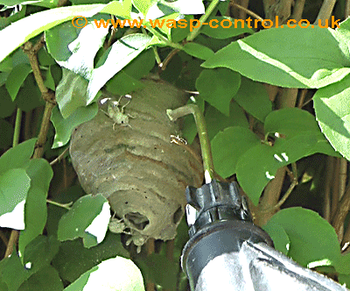
Understanding the Timelines of Wasp Nest Elimination Post-Treatment
Following the treatment of a wasp nest using the described method, the timeline for the demise of the majority of wasps is remarkably prompt. Within a mere couple of hours, a significant portion of the wasp population succumbs to the effects of the treatment, with individual wasps often meeting their demise within minutes of encountering the insecticide dust.
By the end of the day, the entire nest is expected to be rendered lifeless, as the remaining wasps return to their habitat, carrying the contamination with them. While the efficacy of the treatment is comprehensive, there might be isolated instances where one or two wasps do not return to the nest on the treatment day. Factors like being inadvertently trapped in a house or shed overnight could contribute to this occurrence. However, even these stragglers are not exempt from the impact of the insecticide dust. Upon their return to the nest, typically the following morning, they too succumb to the effects of the treatment, contributing to the complete elimination of the nest.
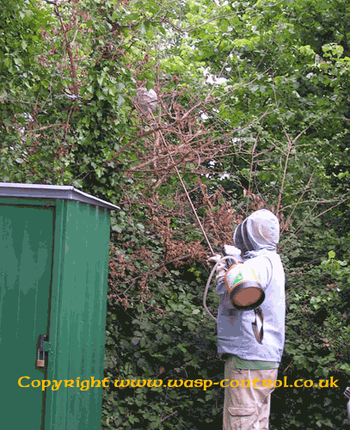
Exploring Immediate Wasp Nest Destruction Options
Is it possible to eliminate a wasp nest instantly? Under certain circumstances, a different treatment approach may be necessary, utilizing what is referred to as a "quick knockdown" insecticide. These quick knockdown solutions often take the form of aerosol-type foam applications conveniently packaged in cans.
Various foam applications exist, but those utilized by professional pest controllers are designated for exclusive professional use. Unlike dust-type insecticides, foam applications demonstrate a faster reaction time and are employed when immediate nest removal is imperative for safety reasons. In essence, these foams ensure the immediate demise of wasps. However, it's essential to acknowledge their limitations. Application requires the nest to be visible, and if instant removal is mandated, any foraging wasps will remain unharmed.
While there are alternative applications like smoke generators available to pest controllers, these are designed for specific circumstances and, once again, are strictly for professional use. Each application type serves a specific purpose, with its advantages and constraints.
Moreover, emerging liquid treatments with instant knockdown properties are gaining attention. However, their use is restricted due to their liquid nature, making them unsuitable for indoor application, among other limitations.
For a comprehensive understanding of wasp nest removal options, visit our dedicated page for more detailed information.
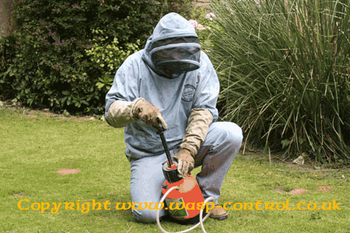
Navigating the Decision to DIY Wasp Nest Removal
Contemplating the removal of a wasp nest yourself is a common dilemma faced by homeowners each year. The discovery of these nests prompts the question: "Should I treat a wasp nest myself?"
Numerous homeowners undertake DIY nest treatments, leveraging various products available in the market specifically designed for wasp control. However, the effectiveness of these products often hinges on factors like experience and possessing the appropriate tools. Unfortunately, many of these DIY solutions come with minimal or no instructions, making the process challenging for those unfamiliar with wasp control techniques.
Professional pest controllers, equipped with specialized knowledge and tools, use treatment products that are not accessible to the general public. These professional-grade solutions enhance the efficiency of wasp nest treatments and contribute to successful outcomes. Therefore, the decision to tackle a wasp nest yourself should be approached with careful consideration, weighing the complexities involved and acknowledging the advantages that professional treatment options bring to the table.
Examining Small Grey Wasp Nests in Spring
As spring unfolds and marks the initiation of wasp nest construction, these incipient structures house only a limited number of wasps. Termed "starter nests," they exhibit a modest size range, typically measuring between 1 to 3 inches in diameter and resembling compact grey golf balls.
Interestingly, in lofts, remnants of these golf ball-sized nests can occasionally be found hanging from rafters, representing nests that never progressed into full-sized structures for various reasons.
Nests surpassing this initial size hint at more substantial developments, accommodating a noteworthy population of wasps. Over the course of the summer, these nests undergo expansion, leading to an increase in the number of individual wasps within them. By the late stages of August into early September, the nests reach their peak strength, marking a period where any interference with a wasp nest becomes potentially perilous.
Understanding the developmental trajectory of a wasp nest over the summer provides valuable insights into its growth and dynamics during this period. Explore the fascinating journey of a wasp nest as it evolves over the course of the season.
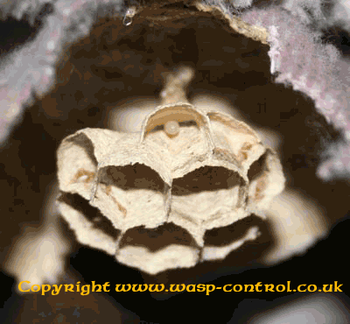
Aggressive Wasps: Understanding Their Defensive Behavior
The formidable reputation of aggressive wasps is a result of a delicate interplay between their instinctive defensive behaviors and the sheer multitude of individuals within their nests. Each wasp nest is a unique entity, and the prevailing mood is intricately tied to the temperament of the reigning queen wasp. Interestingly, the response to nest treatments can be diverse; while some nests maintain a calm demeanor, others may launch a preemptive attack even before the intervention is completed.
For individuals with allergies, exercising utmost caution is paramount to avoid not only wasp stings but also those from other stinging insects. The potential life-threatening consequences of wasp and bee stings emphasize the importance of understanding and managing these encounters. For a more in-depth exploration of strategies and information related to handling wasp stings, we invite you to delve into the comprehensive details provided on our dedicated page.
Ensuring Effective Wasp Nest Management: Dos and Don'ts
When it comes to blocking wasp nest entrances, it's crucial to adopt effective strategies while avoiding counterproductive measures. Here's a comprehensive guide to steer you in the right direction:
- Dos:
- Professional Intervention: Consider seeking assistance from pest control professionals for safe and effective wasp nest removal.
- Observation: Monitor wasp activity from a safe distance to better understand their behavior.
- Don'ts:
- Blocking Entrances: Avoid the temptation to block the entrance to a wasp nest. Wasps are resourceful and may find alternative exits, potentially leading to them chewing through plasterboard and infiltrating your home.
- Expanding Foam: Refrain from using expanding foam as an attempt to eliminate a wasp nest. This method is ineffective and may exacerbate the situation.
- Extreme Measures: Steer clear of drastic actions such as attempting to set fire to a wasp nest, using fireworks, dynamite, or any other explosives. These methods pose significant risks and are not recommended for safe and controlled nest removal.
By adhering to these guidelines, you can navigate wasp nest management with clarity and safety in mind. Always prioritize methods that ensure the well-being of both yourself and the environment.



